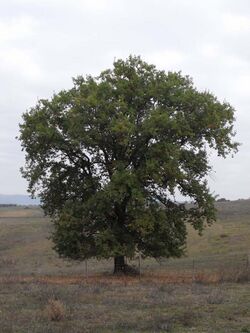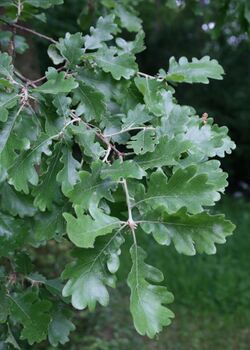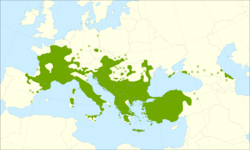Biology:Quercus pubescens
| Downy oak | |
|---|---|

| |
| A mature tree | |

| |
| Leaves | |
| Scientific classification | |
| Kingdom: | Plantae |
| Clade: | Tracheophytes |
| Clade: | Angiosperms |
| Clade: | Eudicots |
| Clade: | Rosids |
| Order: | Fagales |
| Family: | Fagaceae |
| Genus: | Quercus |
| Subgenus: | Quercus subg. Quercus |
| Section: | Quercus sect. Quercus |
| Species: | Q. pubescens
|
| Binomial name | |
| Quercus pubescens | |

| |
| Distribution map | |
| Synonyms | |
|
List
| |
Quercus pubescens (synonyms virgiliana), commonly known as the downy oak, pubescent oak or Italian oak, is a species of white oak (genus Quercus sect. Quercus) native to southern Europe and southwest Asia. It is found from northern Spain (Pyrenees) and France in the West to Turkey and the Caucasus in the East.
Description
Quercus pubescens is a medium-sized deciduous tree growing up to 20 metres (66 feet).[2] Forest-grown trees grow tall, while open-growing trees develop a very broad and irregular crown. They are long-lived, to several hundred years, and eventually grow into very stout trees with trunks up to 2 m (6 1⁄2 ft) in diameter. Open-grown trees frequently develop several trunks. The bark is very rough, light gray and divided into small flakes. Large trees develop very thick whitish bark cracked into deep furrows, similar to the pedunculate oak but lighter in colour.
The twigs are light purple or whitish, with tomentum. The buds are small (3–6 millimetres or 1⁄8–1⁄4 inch) and blunt, light brown. The leaves are leathery usually 4–10 centimetres (1 1⁄2–4 in) long (rarely to 13 cm) and 3–6 cm wide, usually widest beyond the middle. The leaves group at the ends of twigs. The upper leaf surface is dark green and rough, the lower light green. Both leaf surfaces are covered with minute pubescence which is sometimes lost in older leaves by late summer. The young expanding leaves are whitish or pinkish with very soft tomentum. The leaf shape is very variable, divided into 3–7 pairs of deep or shallow lobes, which are usually divided into a few sublobes. The lobes are usually blunt, rarely sharp. The apex is usually wide and round. The base of the leaf is heart shaped, widely rounded or sometimes pointed. The petioles are 4–15 mm (rarely to 22 mm) long, stout and pubescent. The leaves are persistent late into the autumn, remaining green up to early winter. They eventually turn russet or brown and fall off.
The Quercus pubescens acorns are light brown to yellow, 8–20 mm long, usually thin and pointed. The acorn cups are light gray to almost white, with pointed, overlapping scales, covered with tomentum. The acorn stalks are thick and pubescent, up to 2 cm long. The acorns usually occur in groups of 2–5 on the same stalk.
Subspecies
Three subspecies are accepted by Flora Europaea:
- Quercus pubescens subsp. pubescens – central and southern Europe.
- Quercus pubescens subsp. anatolica O.Schwarz – southwest Asia, southeast Europe.
- Quercus pubescens subsp. palensis (Palassou) O.Schwarz – northern Spain, Pyrenees.
Habitat
Downy oaks typically grow in dry, lime-rich soils. It is a sub-Mediterranean species, growing from the coastline to deep in the continent. Its optimum is in transitional Mediterranean-oceanic climates, characterized by warm to hot, dry summers and cool (though not mild) winters with ample precipitation.
References
- ↑ Jerome, D.; Vazquez, F. (2018). "Quercus pubescens". IUCN Red List of Threatened Species 2018. https://www.iucnredlist.org/species/194223/2304788. Retrieved April 4, 2023.
- ↑ "Quercus pubescens". Oaks of the World. http://oaksoftheworld.fr/quercus_pubescens.htm.
- Flora Europaea: Quercus pubescens
- Bean, W. J. (1976). Trees and shrubs hardy in the British Isles 8th ed., revised. John Murray.
- Rushforth, K. (1999). Trees of Britain and Europe. HarperCollins ISBN:0-00-220013-9.
- (in French) Chênes: Quercus pubescens
- Quercus pubescens and Quercus virgiliana - information, genetic conservation units and related resources. European Forest Genetic Resources Programme (EUFORGEN)
Wikidata ☰ Q161415 entry
 |



